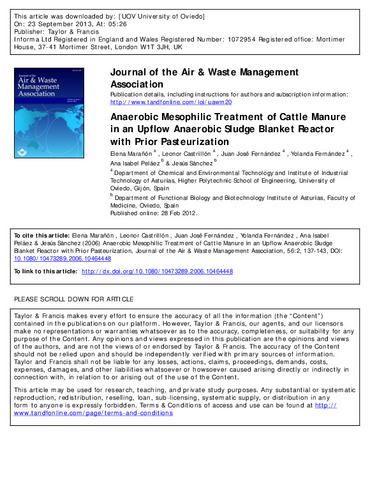Anaerobic Mesophilic Treatment of Cattle Manure in an Upflow Anaerobic Sludge Blanket Reactor with Prior Pasteurization
Palabra(s) clave:
Anaerobic treatment
Cattle manure
UASB
Pasteurization
Fecha de publicación:
Editorial:
Taylor & Francis
Versión del editor:
Citación:
Descripción física:
Resumen:
Different autonomous communities located in northern Spain have large populations of dairy cattle. In the case of Asturias, the greatest concentration of dairy farms isfound in the areas near the coast, where the elimination of cattle manure by means of its use as a fertilizer may lead to environmental problems. The aim of the present research work was to study the anaerobic treatment of the liquid fraction of cattle manure at mesophilic temperature using an upflow anaerobic sludge blanket (UASB)reactor combined with a settler after a pasteurization process at 70 °C for 2 hr. The manure used in this study came from two different farms, with 40 and 200 cows, respectively.The manure from the smaller farm was pretreated in the laboratory by filtration through a 1-mm mesh, and the manure from the other farm was pretreated on the farm by filtration through a separator screw press (0.5-mm mesh). The pasteurization process removed the pathogenic microorganisms lacking pores, such as Enterococcus,Yersinia, Pseudomonas, and coliforms, but bacterial spores are only reduced by this treatment, not removed. The combination of a UASB reactor and a settler proved to be effective for the treatment of cattle manure. In spite of the variation in the organic loading rate and total solids in the influent during the experiment, the chemical oxygen demand (COD) of the effluent from the settler remained relatively constant, obtaining reductions in the COD of 85%.
Different autonomous communities located in northern Spain have large populations of dairy cattle. In the case of Asturias, the greatest concentration of dairy farms isfound in the areas near the coast, where the elimination of cattle manure by means of its use as a fertilizer may lead to environmental problems. The aim of the present research work was to study the anaerobic treatment of the liquid fraction of cattle manure at mesophilic temperature using an upflow anaerobic sludge blanket (UASB)reactor combined with a settler after a pasteurization process at 70 °C for 2 hr. The manure used in this study came from two different farms, with 40 and 200 cows, respectively.The manure from the smaller farm was pretreated in the laboratory by filtration through a 1-mm mesh, and the manure from the other farm was pretreated on the farm by filtration through a separator screw press (0.5-mm mesh). The pasteurization process removed the pathogenic microorganisms lacking pores, such as Enterococcus,Yersinia, Pseudomonas, and coliforms, but bacterial spores are only reduced by this treatment, not removed. The combination of a UASB reactor and a settler proved to be effective for the treatment of cattle manure. In spite of the variation in the organic loading rate and total solids in the influent during the experiment, the chemical oxygen demand (COD) of the effluent from the settler remained relatively constant, obtaining reductions in the COD of 85%.
ISSN:
Patrocinado por:
Spanish Ministry of Science and Technology, contract no. REN2002–01969 TECNO.
Colecciones
- Artículos [37546]
- Ingeniería Química y Tecnología del Medio Ambiente [354]
Ficheros en el ítem




